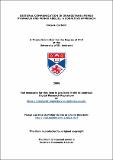Files in this item
Gestural communication in orangutans (Pongo pygmaeus and Pongo abelii) : a cognitive approach
Item metadata
| dc.contributor.advisor | Byrne, Richard W. | |
| dc.contributor.author | Cartmill, Erica A. | |
| dc.coverage.spatial | 250 | en |
| dc.date.accessioned | 2009-01-14T16:19:46Z | |
| dc.date.available | 2009-01-14T16:19:46Z | |
| dc.date.issued | 2009-06 | |
| dc.identifier.uri | https://hdl.handle.net/10023/634 | |
| dc.description.abstract | While most human language is expressed verbally, the gestures produced concurrent to speech provide additional information, help listeners interpret meaning, and provide insight into the cognitive processes of the speaker. Several theories have suggested that gesture played an important, possibly central, role in the evolution of language. Great apes have been shown to use gestures flexibly in different situations and to modify their gestures in response to changing contexts. However, it has not previously been determined whether ape gestures are defined by structural variables, carry meaning, are used to intentionally communicate specific information to others, or can be used strategically to overcome miscommunication. To investigate these questions, I studied three captive populations of orangutans (Pongo pygmaeus and P. abelii) in European zoos for 10 months. Sixty-four different gestures, defined through similarities in structure and use, were included in the study after meeting strict criteria for intentional usage. More than half of the gesture types were found to coincide frequently with specific goals of signallers, and were accordingly identified as having meanings. Both structural and social variables were found to determine gesture meaning. The recipient’s gaze in both the present and the past, and the recipient’s apparent understanding of the signaller’s gestures, affected the strategies orangutans employed in their attempts to communicate when confronted with different types of communicative failure (e.g. not seeing, ignoring, misunderstanding, or rejecting a gesture). Maternal influence affected the object-directed behaviour and gestures of infants, who shared more gestures with their mothers than with other females. These findings demonstrate that gesture can be used as a medium to investigate not only the communication but also the cognition of great apes, and indicate that orangutans are more sensitive to the perceptions and knowledge states of others than previously thought. | en |
| dc.format.extent | 40790237 bytes | |
| dc.format.mimetype | application/pdf | |
| dc.language.iso | en | en |
| dc.publisher | University of St Andrews | |
| dc.rights | Creative Commons Attribution-NonCommercial-NoDerivs 3.0 Unported | |
| dc.rights.uri | http://creativecommons.org/licenses/by-nc-nd/3.0/ | |
| dc.subject | Gesture | en |
| dc.subject | Evolution of language | en |
| dc.subject | Great ape | en |
| dc.subject | Primate | en |
| dc.subject | Intentionality | en |
| dc.subject | Orang-utan | en |
| dc.subject | Orangutan | en |
| dc.subject.lcc | QL737.P96C28 | |
| dc.subject.lcsh | Orangutan--Behavior | en |
| dc.subject.lcsh | Animal communication | en |
| dc.subject.lcsh | Gesture | en |
| dc.subject.lcsh | Cognition in animals | en |
| dc.title | Gestural communication in orangutans (Pongo pygmaeus and Pongo abelii) : a cognitive approach | en |
| dc.type | Thesis | en |
| dc.type.qualificationlevel | Doctoral | en |
| dc.type.qualificationname | PhD Doctor of Philosophy | en |
| dc.publisher.institution | The University of St Andrews | en |
| dc.publisher.department | School of Psychology | en |
This item appears in the following Collection(s)
Except where otherwise noted within the work, this item's licence for re-use is described as Creative Commons Attribution-NonCommercial-NoDerivs 3.0 Unported
Items in the St Andrews Research Repository are protected by copyright, with all rights reserved, unless otherwise indicated.


